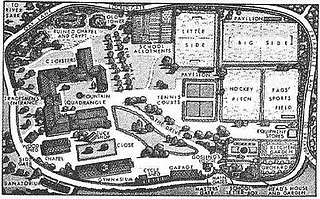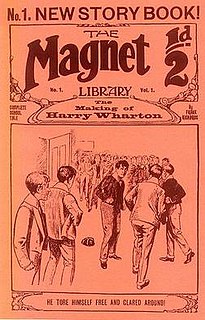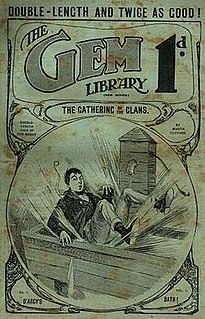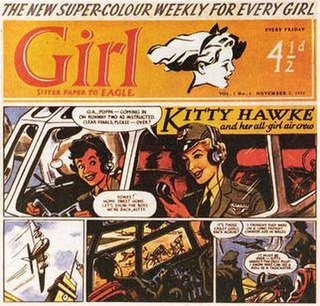Related Research Articles

Greyfriars School is a fictional English public school used as a setting in the long-running series of stories by the writer Charles Hamilton, who wrote under the pen-name of Frank Richards. Although the stories are focused on the Remove, whose most famous pupil was Billy Bunter, other characters also featured on a regular basis.

Charles Harold St. John Hamilton was an English writer, specialising in writing long-running series of stories for weekly magazines about recurrent casts of characters, his most frequent and famous genre being boys' public school stories, though he also dealt with other genres. He used a variety of pen-names, generally using a different name for each set of characters he wrote about, the most famous being Frank Richards for the Greyfriars School stories. Other important pen-names included Martin Clifford, Owen Conquest and Ralph Redway. He also wrote hundreds of stories under his real name such as the Ken King stories for The Modern Boy.

William George Bunter is a fictional schoolboy created by Charles Hamilton using the pen name Frank Richards. He features in stories set at Greyfriars School, originally published in the boys' weekly story paper The Magnet from 1908 to 1940. The character has appeared in novels, on television, in stage plays, and in comic strips.
The Amalgamated Press (AP) was a British newspaper and magazine publishing company founded by journalist and entrepreneur Alfred Harmsworth (1865–1922) in 1901, gathering his many publishing ventures together under one banner. At one point the largest publishing company in the world, AP employed writers such as Arthur Mee, John Alexander Hammerton, Edwy Searles Brooks, and Charles Hamilton; and its subsidiary, the Educational Book Company, published The Harmsworth Self-Educator, The Children's Encyclopædia, and Harmsworth's Universal Encyclopaedia. The company's newspapers included the Daily Mail, the Daily Mirror, The Evening News, The Observer, and The Times. At its height, AP published over 70 magazines and operated three large printing works and paper mills in South London.

The Magnet was a United Kingdom weekly boys' story paper published by Amalgamated Press. It ran from 1908 to 1940, publishing a total of 1,683 issues.

The Gem (1907–1939) was a story paper published in Great Britain by Amalgamated Press in the early 20th century, predominantly featuring the activities of boys at the fictional school St. Jim's. These stories were all written using the pen-name of "Martin Clifford," the majority by Charles Hamilton. Many issues also included a shorter serial story ; these parts of the paper were not written by Charles Hamilton.
Elizabeth Gertrude Bunter, better known as Bessie Bunter, is a fictional character created by Charles Hamilton, who also created her more famous brother Billy Bunter.
The Schoolgirls' Own was a British weekly story paper aimed at girls. Published by Amalgamated Press, it was launched in February 1921 and ran for 798 issues until May 1936, when it was merged with a sister publication.

Girl was the name of two weekly comics magazines for girls published by IPC Magazines in the United Kingdom.
Reginald Thompson Eves was a British editor and writer of comics and story papers for the Amalgamated Press.

Billy Bunter of Greyfriars School is a school story by Charles Hamilton writing as Frank Richards, using the characters and settings of the Greyfriars School stories published from 1908 to 1940 in The Magnet. The retail price was 5 shillings.
Charles Henry St. John Cooper was a prolific English novelist of school and adventure fiction. He wrote thousands of stories for several Amalgamated Press papers, sometimes under the pen name Mabel St. John. He is perhaps best known for creating, in 1908, the character Pollie Green, considered the "most popular, though not the first, in a series of irrepressible schoolgirl heroines". According to his son, he also wrote many "authorless" Sexton Blake stories for the Union Jack. His novel Sunny Ducrow was adapted into a 1926 film, Sunny Side Up.
John Savile Lumley was a prolific English book illustrator, and poster designer best known for his 1915 war recruitment poster Daddy, what did you do in the Great War?
British girls' comics flourished in the United Kingdom from the 1950s through the 1970s, before beginning to decline in popularity in the 1980s and 1990s. Publishers known for their girls' comics included DC Thomson and Fleetway/IPC. Most titles appeared weekly, with the content primarily in picture-story format. The majority of the stories were serialized, with two or three pages per issue, over eight to twelve issues. They were marketed toward young teen girls.
School Friend was the name of two different weekly publications marketed toward girls, both of which were pioneering in their respective categories. The first School Friend, published from 1919 to 1929, was the first story paper marketed exclusively to girls. The second School Friend, published from 1950 to 1965, is considered the first British girls' comic. Although both published by Amalgamated Press, and both marketed toward girls, the content of the two publications was not directly related.

Girls' Crystal was a British weekly story paper and then a comic book published by Amalgamated Press (AP) that ran from 1935 to 1963. Along with School Friend and Girl, it was one of the first British girls' comics.

June was a weekly British girls' comic published from 18 March 1961 to 15 June 1974 by Fleetway Publications, when it merged into the fellow Fleetway title Tammy. June featured a mix of text serials and comic strips.
References
- 1 2 Reed, Sylvia, The Schoolgirl, Comics UK, retrieved 6 July 2010[ dead link ]
- 1 2 3 "The Schoolgirl," Friardale Website. Retrieved March 10, 2021.